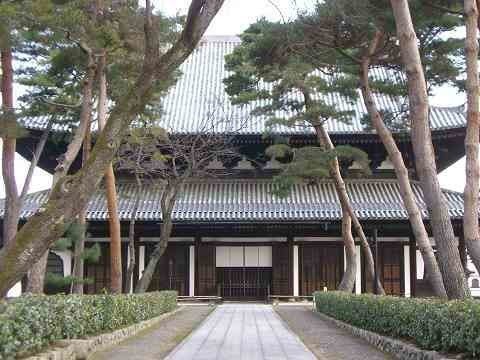
狩野光信の蟠龍図、睨みをきかす 「龍をたずねて―」シリーズⅢ ‐相国寺‐
京都御所の北の門、今出川御門の前の通りを北へ行くと相国寺がある。正式名称は萬年山相國承天禅寺(まんねんざんしょうこくじょうてんぜんじ)という。十四世紀末、室町幕府三代将軍の足利義満により創建された禅寺。境内には本山相国寺をはじめ、十三の塔頭寺院と、山外塔頭に鹿苑寺(金閣寺)、慈照寺(銀閣寺)、真如寺がある。さらに、全国に百カ寺の末寺を擁する巨大禅寺である。
Go north on the street in front of Imadegawa Gomon, the northern gate of Kyoto Imperial Palace, and you will find Shokoku-ji Temple. The official name is Mannenzan Shokoku Jyotenzen-ji. Zendera temple built by Yoshimitsu Ashikaga, the third shogun of the Muromachi Shogunate, at the end of the 14th century. On the precincts, there are the Shokoku-ji and thirteen Tatsuchu(small temple is located on the precints of the main temple), and at the outside of the Tatsuchu there are Rokuon-ji (Kinkaku-ji), Jisho-ji (Ginkaku-ji) and Shinnyo-ji. In addition, it is a huge Zen temple that has hundred temples around the country.
余談であるが、京都の禅宗系には五山之制というものがある。京都五山の寺格を表すものらしい。その第一位が天龍寺、第二位が相国寺になっている。ちなみに第三位が建仁寺、そして東福寺、万寿寺と続く。では、あの南禅寺は?というと「寺格五山之上」ということらしい。つまり、最上級位にあたる禅寺になる。
As an aside, among the Zen sects in Kyoto, there is the Gozan-no-Sei. It seems to represent the temple of Kyoto Gozan. The first place is Tenryu-ji and the second place is Shokoku-ji, the third place is followed by Kennin-ji, Tofuku-ji and Manju-ji. Then, what is that Nanzen-ji temple? In other words, it is the highest level Zen temple in Kyoto.

相国寺本堂 / Shokoku-ji Temple Hondo
さて、本題の相国寺の天井画は蟠龍図である。慶長10年(1605)相国寺の法堂が創建されたときに、安土桃山時代の狩野派総師、狩野光信によって描かれたものである。本図は、円相内に龍の全容をくっきりと描き出されていて、彩色も綺麗に残っている。しかしながら、円相外に雲が描かれていたようだが、剥落し、今は僅しか残っていない。
By the way, the ceiling painting of Shokoku-ji, which is the main theme, is a figure of Banryu. It was painted by the Kano sect of the Azuchi-Momoyama period, Mitsunobu Kano, when the temple in Shokoku-ji was built in Keicho 10 (1605). In this figure, the whole image of the dragon is clearly depicted in Yen Circle, and the coloring remains beautiful. However, clouds seemed to have been drawn outside of Yen circle, but they had fallen off, and now only a few remain.

法堂の天井画 蟠龍図 (狩野光信筆) / Banryu figure
堂内中央付近で手をたたくと、天井に反響してカラカラという音が返ってくるので、別名「鳴き龍」ともよばれている。訪れた折にはぜひ手をたたき楽しんでいただくのもよい。
※蟠龍図は、雲龍図の中の双龍図、蒼龍図のひとつで、とぐろを巻き天に昇らない龍を描いた図
If you clap your hands near the center of the hall, the sound will echo back to the ceiling, and the sound will come back.
It is good to clap your hands when you visit.
* Banryu figure is one of the Soryu and Soryu(blue) figures in the Unryu figure, depicting a dragon that rolls and does not rise to heaven.
レポート / 渡邉雄二
Reported by Yuji Watanabe
よろしければサポートお願いします。日本の伝統文化に関心を寄せています。若いころに文化圏の異なる地域の方たちとの交流で日本のことをあまりにも知らなかったことに気づかされ、それがきっかけで広く浅く学んでいます。拙いレポートですが、お目に留めていただければ幸です。
